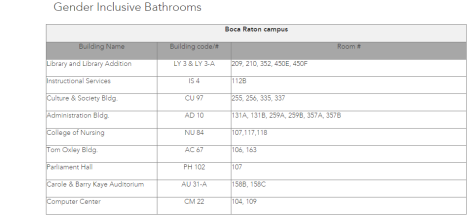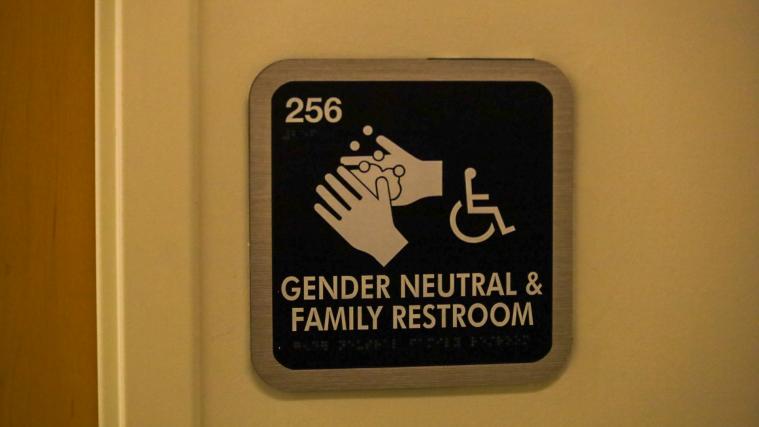‘I just want to pee in peace’: University students say gender-neutral bathrooms are inaccessible
Students propose that there should be an increase in gender-neutral bathrooms to accommodate the diverse student body on campus.
November 23, 2021
Editor’s Note: A source within this article has chosen to omit their last name due to concerns for safety.
Gendered bathroom signs advise students to use the bathroom to correspond with their gender identity, but that doesn’t work for all students.
Coordinator of Space Utilization and Analysis Corina Mavordin said that the university has a total of 515 restrooms including those in Henderson University High School.
“There are 30 gender-neutral bathrooms on the Boca campus. The gendered bathrooms are divided 50-50,” Mavordin said.
While the university has gender-neutral bathrooms on campus, students say they aren’t as relatively accessible as gendered bathrooms.
Ky Walker, a sophomore social work major, said that as a transmasculine individual, the issue of accessibility is a major inconvenience for them as the gender-neutral bathrooms aren’t in places within their vicinity during a routine day on campus.
“I’ve been [at the university] for two years, and I have yet to find [a gender-neutral bathroom] which is frustrating because they are not in places that I frequent every day like the dining hall or the Breezeway. At this point in my transition, I use the men’s room, but it’s not comfortable for me, and I don’t feel safe going in there,” Walker said.
On the Office of LGBTQ+ Initiatives Resource Center site, the gender-neutral restrooms are listed in the following locations:

University maps and handbooks do not list the gender-neutral bathrooms, and when asked if this will be modified, Mavordin noted the significance of the issue but was not able to confirm potential changes to campus resources.
“We are aware that there are discussions related to this subject, but cannot confirm a specific time,” Mavordin said.
Cristina Yelvington, coordinator of LGBTQ+ Initiatives at the University of South Florida explained that on the USF Tampa campus there are approximately 95 single stall and gender-inclusive restrooms. The information on those restrooms can be found on an interactive map.
“Students have expressed discontentment with the number of gender-inclusive restrooms there are on campus, particularly in older academic buildings. We know that lack of access to gender-inclusive restrooms is a barrier for trans+ and nonbinary students to engage fully in campus life, both academically and socially,” Yelvington said.
Yelvington said that she hoped that virtual resources could continue to support the experience of students at the USF campus.
“I hope that the gender-inclusive restroom map makes it easier for our trans+ and nonbinary students to map out their walking routes between classes and makes their overall experience on campus easier,” Yelvington said.
Isabella “Isa” Marin, a junior English major, explained that despite the university’s initiative to modify the gender-neutral bathrooms, their inaccessibility of placement remains paramount.
“There’s definitely a trend of slapping gender-neutral signs onto single-stall bathrooms and calling it a diversity initiative. While it looks great on paper, it’s not so great when I’m bursting at the seams and the only bathroom near me has a stickman with a skirt plastered on the door,” Marin said.
Marin uses they/them pronouns as they identify as non-binary, which refers to one who does not identify as male or female as their identity is outside the gender binary.
When asked if the number of gender-neutral bathrooms is proportional to the number of trans and/or non-binary identifying students on campus Mavordin responded, “We do not know.”
Jude is a senior English major who asked to go only by their first name because of safety concerns. They expressed that the gender-neutral bathrooms on the campus are a step towards ensuring security for trans-identifying students.
Jude’s pronouns are they/them and they identify as a non-binary trans person.
“As we, slowly, head into a more accepting society and more trans people feel comfortable with coming out or some not even feeling the need to come out, it absolutely is something that is vital for trans inclusion in schools. I think [the gender-neutral bathrooms] ensures safety for trans adults and trans youth and is a step in alleviating gender dysphoria,” Jude said. “I think people tend to forget that there is intersectionality within the trans community like trans people with disabilities that would benefit from accessible non-gendered bathrooms.”
Sophomore English major Vanessa Allen explained that her opinion on the matter stems from a difference in culture. Allen is of Jamaican lineage, which she thinks may influence her stance on the issue.
“I am not overly bothered by the issue of gender-neutral bathrooms, neither by their presence nor their absence. I think my nonchalance stems from my different cultural perspective but as long as we all have our stalls, any sex or lack thereof can use the bathroom I use,” Allen said. “I believe that the university should make gender-neutral bathrooms as accessible as regular bathrooms. Anything less defeats the purpose of providing an alternative.”
Marin also said that while the placement of the university bathrooms isn’t perfect, their existence does offer the sentiment of inclusivity.
“At the end of the day, a toilet is a toilet, not a personal identity marker. Most people use gender-neutral bathrooms just by virtue of living at home. FAU’s designation of these bathrooms isn’t flawless, but it’s a step towards reconceptualizing the bathroom as a space inclusive for all,” Marin said.
On the subject of if someone doesn’t look masculine or feminine enough to use a particular restroom, and isn’t near a gender-neutral bathroom Marin explained that they encounter this obstacle daily.
“It’s less of a ‘what-if’ and more of my day-to-day. I lack the resources to align my self-presentation with my gender fluidity, so I often wave a white flag and enter the ‘right’ bathroom,” Marin said.
Walker usually chooses to not use the bathroom in public areas due to unsafety.
“Transitioning is not the goal to pass. I’ve been very lucky to have been able to medically transition, and I look almost like a cis-gender male at times. I have privilege in that aspect and I can go into the men’s bathroom, but it’s still not a safe environment for me,” Walker said.“A lot of times men’s restrooms do not have stalls. If someone doesn’t have access to a gender-neutral bathroom then what are they supposed to do, especially those who aren’t or don’t want to medically transition? They should have access to bathrooms where they feel safe and comfortable.”
Rafaela St. Juste, a junior hospitality major who is a cis-gender woman, said that the restroom a person chooses to enter should be up to them.
“They have the right to choose which bathroom they are going to use. Using the bathroom is a necessity and a person should not be kicked out of the bathroom because they do not fit someone’s standards of masculinity or femininity,” St Juste said.
Allen acknowledged that while she would initially be surprised by the sight of a male-presenting individual in the women’s bathroom, but such an encounter wouldn’t be a cause for serious concern.
“I admit I’d be shocked if I saw a masculine-looking person in the female bathroom but I’d get over it as should everyone else. I believe America is evolving to the point where things like this will no longer be taboo,” Allen said.
Walker said that every trans individual is at a different stage in their journey and there should be more options for accommodation.
“Every trans person is different, and they need somewhere where they can feel comfortable and safe. They shouldn’t be forced to go into a situation where they are unsafe or have no options at all. Being a transgender person, typically, I’m like the only person like myself in the room, and the whole world is not designed for someone like me. Gender-neutral bathrooms should be more accessible, it would be a lot easier for everyone,” Walker said.
Jude explained that fear of safety weighs heavily on members of the trans community.
“I think that many trans people go into gendered bathrooms often in fear, particularly trans women who feel as though they still need to use the men’s room. Personally, as a nonbinary person, I avoid public restrooms because I know that I will be using the woman’s room and it is just an added reminder that my identity is not necessarily not valid but rather it’s overlooked,” Jude said.
Marin expressed that gender presentation has significantly influenced the experience of non-binary and trans-identifying students in their attempts to use the restroom.
“Unfortunately, androgyny has become key for non-binary students, and total conformation to the gender binary for trans-identifying students. Without either, it feels like we’re not permitted to enter. I just want to pee in peace,” Marin said.
Kayla Connors, a junior English major who identifies as non-binary explained that an increase in gender-neutral bathrooms would encourage more safety among the diverse student body on campus.
“Gendered bathrooms are often sites of violence for both trans and non-binary students, whether that violence is physical or psychological. I think that having gender-neutral bathrooms accessible in all buildings makes it explicit that all identities are safe and welcome to use those facilities. Gender-neutral facilities allow for students of any identity to attend to their business without complication or fear, using the bathroom shouldn’t be anxiety-inducing. In the words of Tarō Gomi, ‘Everybody poops,’” Connors said.
Darlene Antoine is the Features Editor for the University Press. For information regarding this or other stories, email antoined2019@fau.edu.







